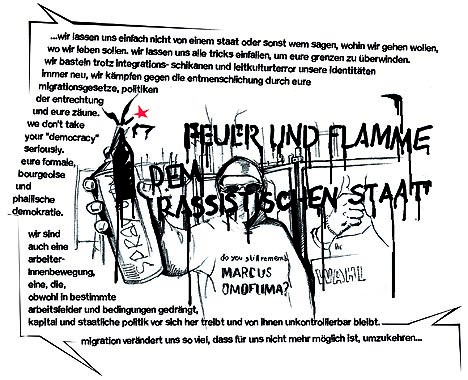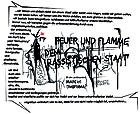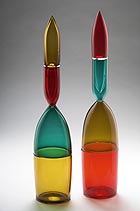
translated and summarized by: Liz Wollner-Grandville,
English summaries October 25 - November 7
Kunstraum Niederoesterreich
Mit uns ist kein (national) staat zu machen (You won't make a (nation)state with us)
01.10.2010 – 11.12.2010
On the State of Nations
“The state is dead. Long live the state”. This statement made during the monarchy and at that time alluding to its continuity, is still very much up to date. After all, according to the most recent surveys, the nation-state, often declared dead in context with globalisation and the EU, is still considered as one of the most significant identity-establishing entities. Xenophobia and appalling asylum policies go hand in hand. The 14 artworks put together by the curators Ursula Maria Probst and Walter Seidl prove how important opposing positions in a political climate of marginalization are. The exhibition was opened prior to the Vienna elections 2010 and the timing could not have been better.
Some of the participating artists have an immigrant background themselves. Anna Jermolaewa fled to Austria in 1989 from St. Petersburg. She confronts the visitor with a disturbing sound installation. “Eat! Eat! Jamjam! Jamjam!” the loudspeakers yell. The artist deals with her memories of the meal distribution at the refugee camp in Traiskirchen, where she was forced to stay when she first arrived in Austria. Ovidiu Anton relates powerfully to the prevailing mood among asylum seekers: “Killing time and observing one’s surroundings” is the title of his video and slide installation, in which he describes his father’s flight from Romania to Austria. Petja Dimitrova protests vociferously against xenophobia in his graffiti-like mural texts, while Michail Michailov’s colour pencil drawing conveys ironic undertones: African animals symbolize the fear of all things considered strange. Grouped closely together they form the geographical outline of Austria. Hansel Satos and Lena Lapschina’s approach to migration is equally humorous: while Lapschina stages asylum seekers as management experts, Sato counteracts the popular prejudice disseminated by mass media with an anti-racist paper disguised as a boulevard magazine.
With this selection of artworks the curators successfully conveyed what is missing in most political debates – a differentiated view of the topics dealing with isolation and integration. Their view is not only limited to Austria and its marginalization mechanisms based on ethnic differences. This is also documented by Ana Hoffner’s contribution of a lecture performance on video, analysing topics such as identity and equal rights from an unusual perspective.
By Manisha Jothady
Kunstraum Niederoesterreich
1010 Vienna, Herrengasse 13
www.kunstraum.net
Opening hours: Tue – Fri 11 a.m. – 7 p.m., Thu 11 a.m. – 8 p.m., Sat 11 a.m. – 3 p.m. Closed on Mondays, Sundays and holidays.
WAGNER:WERK Museum Postsparkasse der BAWAG P.S.K.
Fire and ice – Finnish glass design made in Murano
05.10.2010 – 13.11.2010
Northern lights in the lagoon
Venetian glass could have done with some Nordic clarity, back then, in the fifties. Fascism had been mildly ousted and Gio Ponti and Carlo Scarpa introduced contemporary design to the glass industry. Murano was ready for a brush-up: in the form of Northern European design.
Years of successful fair and world exhibition participation had stimulated Finnish designers and their producers. Awards heightened the entire country’s self-esteem and design attained a standing that up to this day is incomparable to other countries in Central Europe. Alvar Aalto and Kaj Franck worked together with Timo Sarpaneva, Tapio Wirkkala, and Harri Koskinen for the Finish glass foundry iittala. They could be described as the fertile Northern European exports to Murano. Since 1959, following his successful exhibition designs, Wirkkala was a guest designer for Venini, and Sarpaneva designed the iittala-logo that is still in use today.
Paolo Venini founded the same-named glass foundry in 1921 and from the very first day the foundry cooperated with top designers. The “Finns at Venini” (the original title of the exhibition of 100 works taken over be the Finnish glass museum), hired by Venini’s son in law Ludovico Diaz, enjoyed the Italian’s relaxed handling of colour, and in turn, the Italians enjoyed the Finn’s clear and modest forms.
Two-coloured “Incalmo”, delicate glass and sculptural objects with gold inlays and air bubbles are presented at the exhibition in glass cases designed by Wirkkala in the early eighties - virtually floating and illuminated from below. Glass as glass – Paolo Venini would love it.
By Iris Meder
WAGNER:WERK Museum Postsparkasse der BAWAG P.S.K.
1018 Vienna, Georg-Coch-Square 2
www.ottowagner.com
Opening hours: Mon – Wed, Fri 8 a.m. – 3 p.m., Thu 8 a.m. – 5.30 p.m., Sat 10 a.m. – 5 p.m.
Generali Foundation
Ana Torfs – Album / Tracks B
03.09.2010 – 12.12.2010
In the burning glass of a flower
The story seems extremely confusing – and everyone has their own view: Ana Torfs lets actors recite the court files of the murder of Karl Liebknecht and Rosa Luxemburg in a slide-video installation at the Generali Foundation; a silent, but obviously attentive audience in a dissecting room listens to the faltering monologs.
Elsewhere Torfs interweaves quotes from the inquisition protocols against Jeanne d’Arc with photos of a distressed, weeping, and tired woman, a fictitious contemporary saint. Slide installations are the artists preferred media, as it sets the time span of reception to its audience.
Not so the series of wall charts that Torfs uses to present the detailed research results of Carl von Linné's system of classifying and naming plants, thereby also demonstrating his colonialist background. Like a burning glass, a simple botanic description focuses on history and societies – similar to the photo series with the ambiguous title “Legend”, allowing an uninhibited telescopic view onto idyllic landscapes of the Canary Islands and simultaneously listing data and facts of the western desire for the exotic, the other; and, on the other hand, for contemporary migration and exodus.
Torfs’ primary topic – the impossibility to formulate final realities - articulates itself in a reliable and modest form; only the photo series “à…à…aaah!”, which loosely refers to its artistic genesis and in which harlequins and musicians encounter each other, is penetrated by fine humour. But despite all sobriety, Ana Torfs’ works are anything but solemn: their formal design is absolutely sober - one could say as dry as a bone – and they run no danger of appearing weighty or portentous.
By Nina Schedlmayer
Generali Foundation
1040 Vienna, Wiedner Hauptstrasse 15
foundation.gnerali.at
Opening hours: Tue – Fri 11 a.m. – 6 p.m., Thu 11 a.m. – 8 p.m., Sat and Sun 11 a.m. - 4 p.m.
Galerie Hubert Winter
Fred Sandback
17.09.2010 – 16.11.2010
Habitable drawings
The Galerie Hubert Winter presents Fred Sandback’s work for the third time since his death in 2003. The directions that Sandback set and added to the works support the difficult task of reconstructing and adjusting his work to the gallery space.
All of the works are a selection from his legacy in New York and the majority have never been exhibited in the gallery before. They were installed with the help of one of the artist’s former assistants and in the presence of a representative of the legacy, and adapted to the spatial situation.
His work is characterized by monochrome and colour acrylic or rubber strings which he spanned in lines across a room. Works on paper, linocuts, etchings and Photostats amend the retrospective.
The work of Fred Sandback, who belonged to New York’s most important artists during the 1970’s, was partly seen in association with Minimal Art – yet Sandback’s work distinguishes itself by its approach to the creation process as well as its self-understanding.
Minimalists overcome their painting inability through a transmission into the third dimension, and Sandback does something similar with a drawing. He transferred a drawing into three-dimensions and monuments, and from there transposes the sculpture into an imaginary level: “A sculpture that became less of an object in itself and more of a diffuse interface between me, my surroundings and others, who live in these surroundings”, Sandback described his work.
These sculptures have no inner or outer form; he created room drawings that are simultaneously drawings in a room. The factual and actual conjoin by letting the space and the drawing communicate and complement each other; form a unit. “A drawing that one can inhabit”, as Sandback once explained.
By Milena Dimitrova
Galerie Hubert Winter
1070 Vienna, Breite Gasse 17
www.galeriewinter.at
Opening hours: Tue – Fri 11 a.m. – 6 p.m., Sat 11 a.m. – 1 p.m.
Mehr Texte von translated and summarized by: Liz Wollner-Grandville


 Teilen
Teilen





